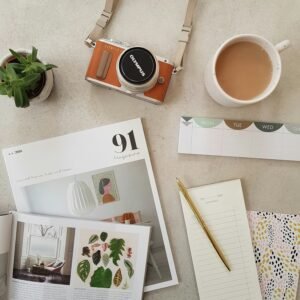Starting an Art Blog: Step-by-Step Guide

Are you a designer or an artist looking to showcase your work to market yourself in search of potential business partners or clients?
Having an art blog is the best means to be discovered, expose your process, and attract readers.
If you want to display your graphic design portfolio, offer inspiring design, or exhibit your artistic portfolio to the world, then this tutorial will lead you through each step in how to start and build a successful art blog.
Why Start an Art Blog?
An art blog isn’t a website where you can simply share your work.
It’s a digital repository for your process, your ideas, and your personality.
Below are reasons why you need an art blog:
- 🎨 Feature Your Artwork: Present your illustration portfolio, motion graphics, or your branding designs in a beautifully edited showcase.
- 🧑💼 Get Clients: It is simpler to get new and freelance clients by having a blog where your expertise can be highlighted.
- 💡 You’re a master when it comes to designing in UX design, UI design, or digital painting.
- 🌟 Inspirational Blogs: Blogs offer a great platform to inspire individuals who share the same interest.
🔧 Step 1: Establish Your Art Blog’s Purpose
🧠 Before going into technical setup, determine your purpose for your blog. Ask yourself:
- I would like to create informative yet interesting content.
- My audience consists of designers, clients, students, and recruiters.
- My goal? (Freelancing, online body of work, sharing knowledge, etc.)
👨🎓 Tip:
As a freelancer, your site can serve as your portfolio and lead generation source.
If you’re a student, it may be more about experimenting and tracking progress.
🖥️ Step 2: Select a Blogging Platform
The popular blogging websites are:
- WordPress – Extremely versatile with excellent SEO capabilities.
- Wix vs. Squarespace – Easier with drag-and-drop capabilities—perfect for showing your web design portfolio in a visual format.
- Ghost versus Webflow – Sleek, modern alternatives for tech-savvy creatives.
Make sure your platform provides:
- 🖼️ Image galleries
- 🎞️ Embedded video (such as motion graphics)
- 🌐 Custom domain names
🌐 Step 3: Choose a Domain and Web Hosting
Pick a domain name which reflects your brand.
Sample options:
- January
- systems.an
- vivid
Solid Web Hosting Options:
- Bluehost
- SiteGround
- Hostinger
- (If you aren’t using Squarespace, you’re lucky)
🎨 Step 4: Create Your Art Blog Layout
Your blog’s design is most critical—it’s your first impression.
Focus on:
- User Experience: Your site should be user-centered and your UX portfolio can serve as proof of the same.
- Visual Hierarchy: Use bold headings, organize clearly, and display your best visual design examples first.
- Mobile responsiveness: Most of your users are going to visit your site from a mobile phone—test it throughly.
- Typography: A well-designed typography presentation will preserve your brand personality and improve readability.
🧩Other Portfolio Section Suggestions
Offer UI, graphic, and brand samples
- Image sliders
- Grid layout
- Carousel view
📝 Step 5: Create Quality Content
This is where your blog truly comes alive. To kick things off, consider these options.
📌 1. Case Studies
Following are two posts:
- Project I
- Sunshine Valley
- Examples
- I designed a new logo for them.
- Analysis of a contemporary illustration portfolio piece
- Case Study: A Client Brand Story
Use images, films, and even GIFs to create an engaging digital art gallery.
📘 2. Tutorials and Walk
Human nature makes people inquisitive. Post your tutorials or your steps on:
- Creating effective UI/UX designs
- Working with Type
- Storyboarding a Motion Graphics Project
💡 3. Inspiration and Moodboards
Provide design inspiration with:
- 🎨 Mood boards
- 🎯 Color schemes
- 📚 Case studies
Highly shareable content that ranks well in search!
🧪 4. Review and Tools
I don’t have any design equipment.
- ✍️ Tablet drawing
- 🧰 Software comparisons
- 🅰️ Typography plugins
Post pros, cons, and how they affect your workflow.
🧑💻 5. Freelance Tips & Advice
As a freelance designer, you can offer your hands-on expertise.
Subjects:
- 💰 Pricing
- 🤝 Relationships with clients
- ✅ Here’s how I got jobs:
- I applied
🔍 Step 6: Search Engine Optimization
Gain exposure for your blog:
- Incorporate keywords naturally (e.g. graphic design portfolio, illustration portfolio, web design gallery)
- 🖼️ Include alt tags for each image (very important!)
- 🔗 Internally link related blog articles and portfolio projects.
A title such as:
“10 Stunning Logo Design Ideas for 2025”
…will attract inspiration hunters and prospective brand buyers.
📣 Step 7: Spread The Word
Let the world see your exceptional work!
Share it On Social Media:
Signup Newsletter:
- Create a subscription list to remain connected.
Online Discussion Boards:
- Behance
- Drib
- Discord Groups
Use Pinterest boards for Mood boards, Visual examples, Web design galleries
🔁 Step 8: Keep It
An outdated blog is a forgotten one.
Make sure to update at least once a month, even.
🧩 Use theme-based content:
- Typography Tuesdays – Weekly typography showcases
- Motion Monday – Featuring new motion graphics examples
- Freelance Friday – Your Freelance Experience Sharing and Advice
📈 Step 9: Track Performance
Use Google Analytics to track:
- Popular posts
- Traffic sources
- Portfolio interaction (such as clicking upon your UI design portfolio)
Let your next ideas be guided by data.
🎯 Final Thoughts
An art blog can be a wonderful launching pad for establishing a brand presence, exhibiting a body of work, and networking with other professionals within your industry.
When you’re sharing a premium quality graphic design portfolio, creating revolutionary logo designs, or creating UX portfolio illustrations, a blog merely allows the work to speak for itself—and grow.
Be original, remain consistent, and be authentic.
So, simply create, simply share, and use your art blog like a playground in cyberspace.
Share:
More Posts

How to Get Started with Concept Art
Anyone who ever marveled at intricate video game worlds, fantasy animated superheroes, and sci-fi film space ships must have been exposed to concept art. Concept

Best Free Online Galleries for Artists
Every artist today must possess a strong web presence. Having an exhibition featured in an online art gallery is among the best methods through which

What Makes a Great Creative Blog?
In the fast-changing world of design, art, and digital imagination today, a creative blog is not a hobbyist pursuit—it’s a tool for self-expression, career development,

Daily Art Prompts to Spark Creativity
All creatives are guilty of that terrible moment of standing before the blank canvas, the blank sketchbook, or the blank screen with no idea where

